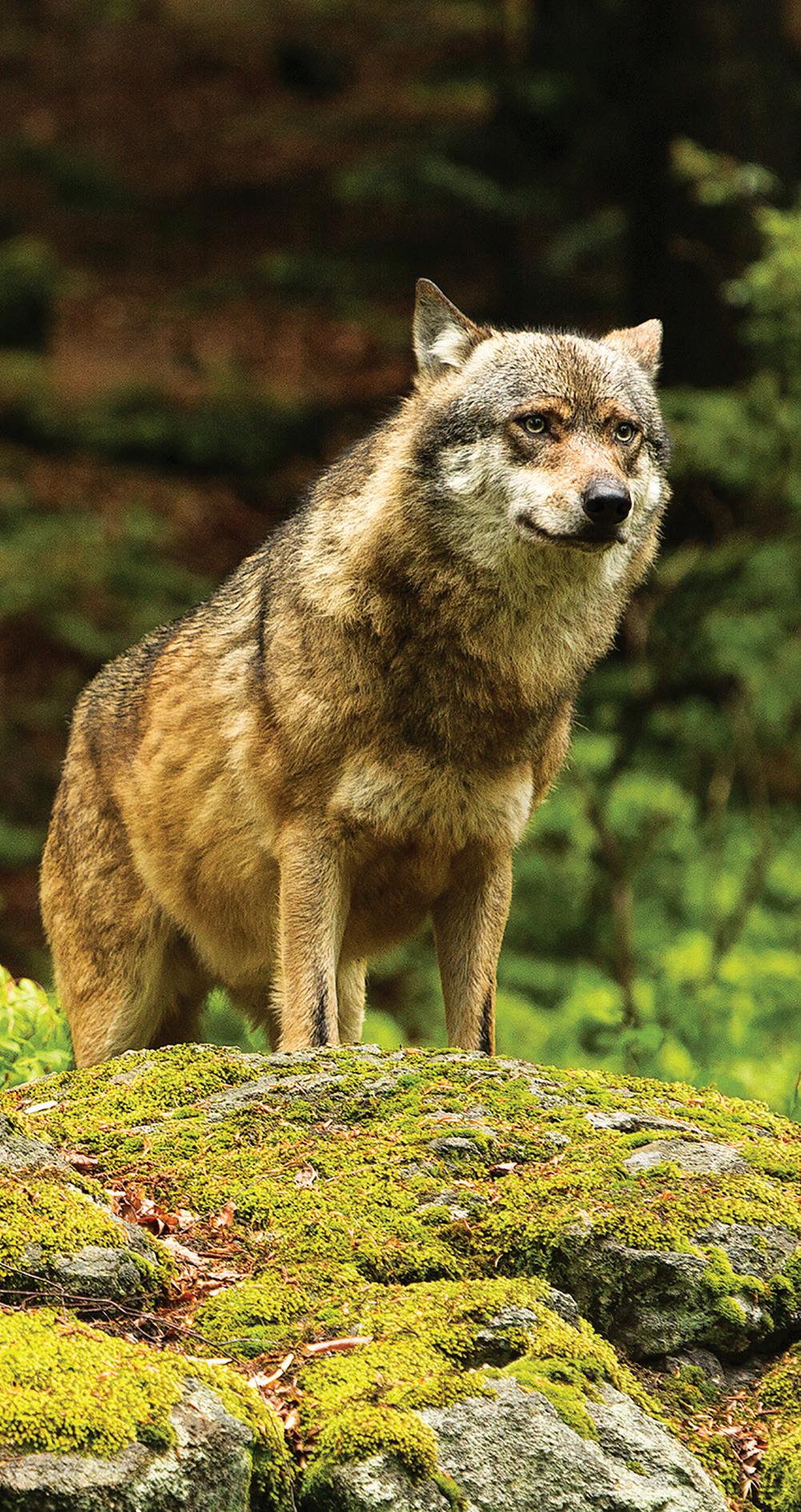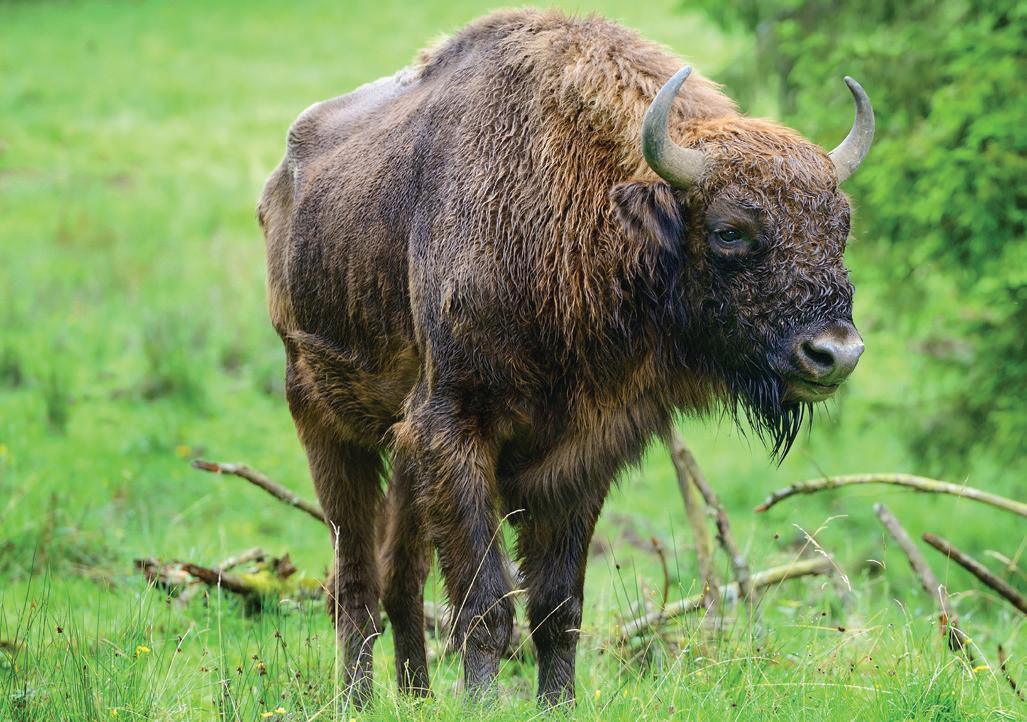
9 minute read
A BEGINNER’S GUIDE TO REWILDING
Féidhlim Harty describes how ‘rewilding’ can produce landscapes with an abundance of plant and wildlife with opportunities for people to thrive socially and economically
We are beginning to recognise that if we don't manage our landscapes in a way that supports the natural world we may well find ourselves without all sorts of things we currently take for granted. 'Rewilding' is all about bringing nature back to life and restoring living systems and allowing nature to flourish.
Advertisement
It’s a relatively new term, coined by conservationist and activist, Dave Foreman, and first appeared in print in 1990. He envisaged rewilding as a large-scale affair with two specific prongs: giving the land back to wildlife and giving wildlife back to the land:
Giving the land back to wildlife involves devoting sufficient protected space to wildlife so that it can thrive, hand-in-hand with sufficient connection with other protected space to prevent genetic islands forming. Such islands (be they in an ocean, a clear cut rainforest, or small remnant of a raised bog) lead inevitably to extinctions over time if the genetic pool is too small to sustain sufficient diversity.
Giving wildlife back to the land involves reintroductions of keystone species; often apex predators. We have become used to greatly denuded habitats when it comes to top predators and large fauna generally. In Ireland, we have lost wolves, bears, giant deer, mammoths and other megafauna, through a combination of climatic shifts and hunting since humans first arrived here. Keystone species reintroductions allow the natural predator-prey relationships to unfold in a way that supports the whole ecosystem.

These elements of rewilding have been summarised as Core, Corridors and Carnivores.

WHY CARNIVORES OR KEYSTONE SPECIES?
What ecologists have discovered in recent decades is that without the full complement of species within a habitat, the whole habitat suffers. European bison and other large grazers; predators like wolves and bears; and the dam-building beaver are amongst the species that have been reintroduced into rewilding projects in Europe over the past decade or so.
Wolves and other top predators can be very useful in controlling both the numbers and behaviour of herbivores, as witnessed over the past 30 years in Yellowstone National Park. Since wolves were reintroduced there, they have essentially kept the deer away from easy grazing along with the open riverbank areas. This has allowed trees to regenerate naturally, to the point where the course of the river is shifting and changing as it once would have done naturally before Europeans cleared the plains of large grazers and their predators.
Carnivores are not the only keystone species, however. An initiative at Knepp Castle Estate in England is an example of a successful rewilding project that relies on the herbivores as the main landscape architects in the project; in a dynamic dance with the emerging plant community. There, longhorn cattle have been chosen to represent the wild cattle of Europe. Tamworth pigs represent the wild boar. Exmoor ponies stand-in for the extinct European wild horse. Finally, the deer are already wild. Between them these animals dig, graze, forage and browse the vegetation, keeping the succession to forest cover in check and allowing a host of natural habitats to emerge within the estate. Without apex predators, human intervention is needed to replicate their role, and thus animals in Knepp are harvested for meat on a periodic basis to keep herbivore numbers in balance with their habitat.
Salmon are a keystone species in some bioregions such as the American North West, bringing nutrients up from the sea into the forests where they are a valuable fertiliser, transported by bears and people (as long as flush toilets don’t undo all the salmon’s hard work and flush the nutrients into the rivers again).
Another keystone species is the beaver. Vegetarian in nature, beavers are a quiet, unobtrusive animal, which would have a considerable tourism value in any wilding project. They have been introduced into parts of England and Scotland and have been shown to improve water quality and wildlife value generally. Unlike apex predators and even larger herbivores, beavers are happy in relatively modest areas. They may even be a viable introduction in Irish river systems if a sufficient riparian corridor is first created to ensure that crops and commercial forestry timber are not damaged by damming.
Although not in the fossil record in Ireland, beavers may well have been present here, having swum across from Scotland or Wales in the distant past. We have bone records of bears and stories of wolves, but perhaps this smaller and probably tasty vegetarian mammal didn’t leave much trace after providing a meal for newly arrived humans and other hungry animals.

CORE-PROTECTED SPACE
So, how much core-protected space is needed to qualify as a rewilding project? EO Wilson’s book, Half-Earth, indicates the scale needed to protect the diversity of life on earth. However, in practical terms, many projects will be more modest than these continent-scale endeavours. For smaller projects, much depends on the area available and on the keystone species being reintroduced. Since wolves are one of the archetypical rewilding keystone species, let’s start with a look at the land area they need. Wolf packs range over areas as large as 50 square miles (or 30,000 acres) – or much more where food is in short supply. So, they are suitable only for the largest of rewilding projects.
To get an idea of the sheer scale involved in supporting such a pack, consider that Knepp Castle Estate in England is 3,000 acres. Wild Nephin Park in Co. Mayo is still well short, at 11,000 acres. Alladale estate in Scotland (where wolf reintroductions are being proposed at present to help regenerate the ancient forests currently denuded by deer) covers 23,000 acres, with plans to double that. So in a nutshell, the core protected area needs to be considerable to support a self-sustaining wild habitat with a full suite of keystone species present.
However, as Knepp has shown, smaller-scale rewilding projects can also offer invaluable wildlife benefits. Smaller still, but no less impressive, is a 250ha enclosure for European bison within the Dutch Kennemerduinen National Park. What is very clear from the experience in both of these examples is that keystone species can take the form of large herbivores; as long as some management input is ensured to replace the role of predator. In essence, the smaller the land area, the more human intervention needed to compensate for the lost species at the top of the food chain.
So perhaps rather than asking the question of how much space is needed? We could ask, how much space is available? Whatever the size, there can be benefits on multiple levels: creating a valuable public amenity, generating economic value, supporting biodiversity, carbon sequestration and improved water quality and hydrology.
CORRIDORS
Corridors between core-protected spaces are an essential component in the overall rewilding of our landscapes. In Ireland, we are blessed with a dense network of hedgerows, which provide invaluable corridors to bees, bats, small mammals and other fauna.
As with hedgerows, many Irish and European habitats have evolved over centuries hand-in-hand with human management practices. Farming in a way that supports wildflowers, insects, birds and other species offers a space for wildlife to thrive and to navigate through the landscape. It also plants the seeds of appreciation in our minds, so that when we create new core protected space within our landscapes on less productive land, we will have already created safe corridors in our farmland, through which animals can pass.
Rivers and streams, and the riparian wetlands alongside them, provide excellent corridors for wildlife. Otters, kingfishers, trout and dragonflies are all wetland species that can thrive in a healthy river system with good interconnections along its length. If carried out with care to protect the wildlife, corridors can also provide the basis for introducing a walking and cycling network to improve local amenities and tourism.
STEPPING FORWARD
On the 10 or so large-scale rewilding projects in Europe, there have been concerns from the farming community about the impact on their livestock, livelihoods and whole way of life. Yet careful project planning and implementation and working hand-in-hand with landowners can allay many of those fears. Recent farming-for-nature projects in Ireland have had great success with this process, being farmer-led. These support landowners financially to make changes that are healthier for wildlife on their farms. The fact that our main agricultural payments system actively excludes spaces for wildlife on our farms can be our greatest opportunity for creating positive changes in these coming years. It’s such an easy one to overhaul and offers so many benefits for farmers and wildlife that it could be changed in the morning to create immediate win-wins.
Whether at the level of core-protected space, corridors through the landscape or by exploring suitable keystone species reintroductions, rewilding may be an answer to many of the questions being raised at present in our society. How do we halt mass extinction? How do we reverse climate breakdown? How can we manage our waterways to better prevent flooding? Why is our topsoil becoming ever more degraded and eroded? What do we need to do to clean up our drinking water, rivers and lakes? Will farming be possible without pollinating insects? Are there diverse, healthy ways to create livelihoods on the land?
We have become used to a narrative in which our impacts are inevitably damaging. This need not be the case. Humans are termed a hyper-keystone species; such is our impact on the landscape. In many instances, European colonists have decimated cultures that had survived many thousands of years by working hand-in-hand with what nature provides, rather than trying to impose their will on the landscape. As we look at the wreckage of our own consumption-driven culture and its impact on the world around us, we could learn much from the wisdom of those societies that see the earth as a sacred being, to be loved and protected rather than suppressed and pillaged. Partnerships between land and livelihood are our future. The biodiversity success of the Burren Programme in Co. Clare lies in the long evolution of the wildflower-rich landscape, born of grazing by large herbivores and traditional livestock management practices. By carefully adopting or returning to measures that support local flora and fauna, we can move forwards to a countryside that supports all of nature; human and non-human alike.
The more we learn about the natural world, the more we realise that people need what nature offers rather than the other way around. In meeting both our own needs and those of the rest of the natural world we could be on the cusp of something truly beautiful. ✽
FÉIDHLIM HARTY is director of FH Wetland Systems and a writer. His most recent books are Permaculture Guide to Reed Beds and Towards Zero Waste. www.wetlandsystems.ie










